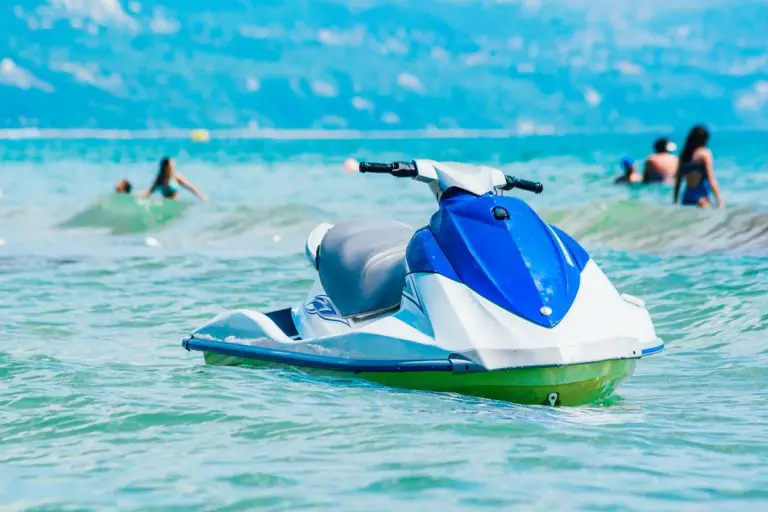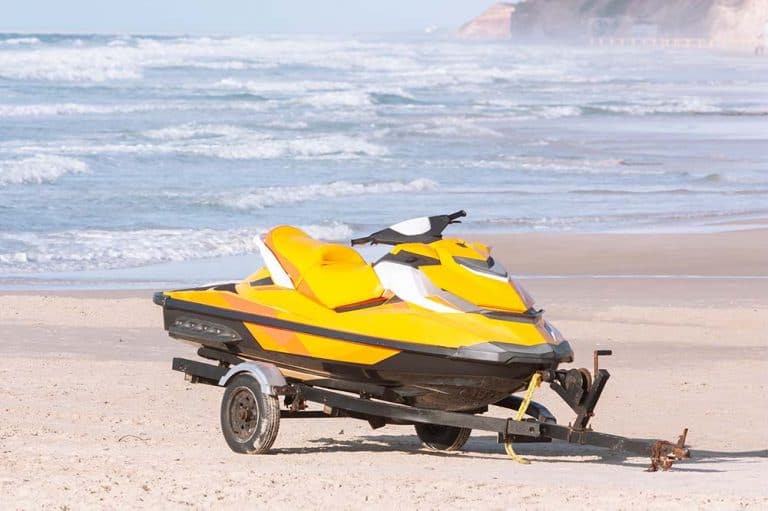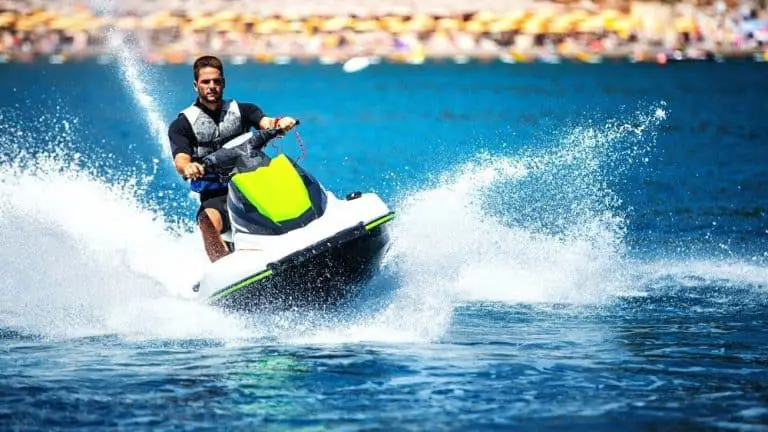Why Does My Jet Ski Keep Turning Off? (7 Reasons & Fixes)
Jet skis can provide hours of entertainment as you glide over the waves. However, they can sometimes be problematic. If your jet ski keeps turning off, you’ll want to find out the reason or reasons it keeps happening.
Your jet ski may keep turning off due to a flooded motor, clogged or faulty part, water-contaminated fuel, dess switch problem, loose connection, or mode issue. Easy fixes include waiting for the fuel to evaporate, cleaning or replacing parts, repairing loose connections, or picking the right mode.
In this article, I’ll explain why your jet ski could be turning off and offer seven helpful fixes.
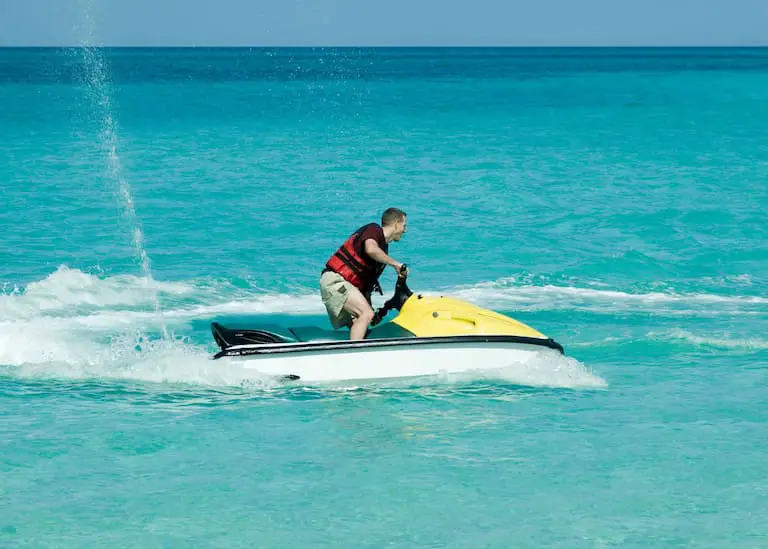
7 Reasons Why Your Jet Ski Could Be Turning Off
When your jet ski randomly turns off or loses power, it can be very concerning, especially if you’re out on the water and far from the shore. Thankfully, a jet ski intermittently turning off doesn’t usually have a serious cause, and you can often fix the problem yourself.
Here are the most common reasons your jet ski may continuously turn off during operation.
Fuel-Flooded Motor Will Turn Off a Jet Ski
A jet ski motor becomes flooded when excess fuel is in the combustion chamber. When this happens, the fuel can saturate the jet ski’s spark plugs, preventing them from igniting. A flooded motor also has too little air to power the engine’s parts, making it seem like your jet ski has turned off when it’s running on little or no power.
Typically, a jet ski’s motor floods when you give it too much throttle when turning on the ignition.
Clogged Part Can Shut Off a Jet Ski
Another common reason jet skis (aka Personal Watercraft or PWC) randomly switch off is due to a clogged part. Jet skis operate close to the water, so their parts are vulnerable to rust and can get clogged with seaweed or vegetation from freshwater lakes or rivers. Although jet skis have powerful motors and normally expel sucked-up material quickly, this isn’t always the case.
If you haven’t used your jet ski in a while, the carburetor may have become clogged with rust or mineral deposits, causing it to work ineffectively. Other clogged parts might have rust or mineral build-up as well.
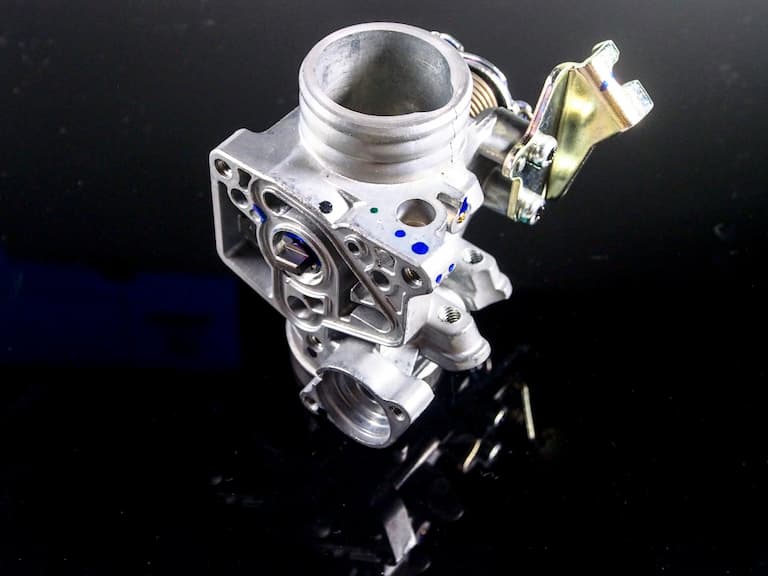
Worn-Out or Faulty Part Can Make a Jet Ski Keep Turning Off
Like all watercraft, jet skis consist of parts that wear down and become faulty over time. When a part is no longer functioning optimally or breaks, the jet ski can switch off. Below are the most common parts that can wear down, break, or make your jet ski intermittently turn off.
- Spark plugs: Spark plugs can become worn out, wet, or saturated with fuel when the motor floods.
- Jet pump: Jet pumps typically have a lifespan of five years, and worn-out pumps can make the jet ski vibrate or stall when it’s idling.
- Key switch: Since you use the key switch each time you turn your jet ski on, it can get damaged or wear down over time.
- Ignition coil: A damaged or worn-down ignition coil can make the engine misfire, stall, or cause the jet ski to lose power.
- Injectors: Faulty, clogged, or worn-out injectors can make your jet ski struggle to start, perform poorly, and stall.
Water-Contaminated Fuel Will Cause a Jet Ski to Stall
Your jet ski may not be performing optimally because you used poor-quality, water-contaminated fuel. Trying to save money by buying cheap fuel for your jet ski isn’t worth it, as these kinds of fuel often contain ethanol, which attracts and absorbs water.
If you’re one of those people who only use their jet skis during the hot and humid summer months, the hot weather can cause bacteria and algae to build up inside the fuel tank. This can lead to poor engine performance and fuel tank corrosion. If you don’t empty the gas tank at the end of summer, the ethanol-rich fuel can absorb more water than you’d like.
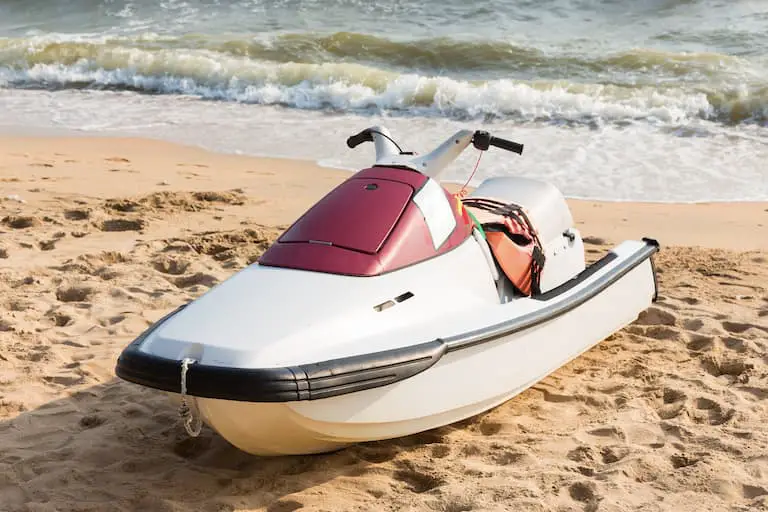
Dess Switch Signal Problem Can Be The Reason Your Jet Ski Turns Off
A jet ski’s dess (short for “digital encoded security system”) is a key with a radio-frequency chip and a unique code that prevents theft. When the jet ski has a dess signal problem, it can intermittently disconnect from the motor, causing it to stall or not start at all. This normally happens in jet skis that are five years or older.
Loose Connection Can Cause a PWC to Turn Off
Since jet skis move at high speeds, their parts can vibrate to the point that they disconnect sometimes — especially in the start/stop switch or battery. Sometimes, the wires connecting a jet ski’s parts have worn-down insulation, making them more likely to erode or wear down.
Using The Wrong Mode Can Make a Jet Ski Keep Turning Off
If you have a modern jet ski, chances are it has various modes for power delivery. You can usually change the modes on the left handlebar. A jet ski that suddenly turns off might be because you’re using the wrong mode. For example, using the slow mode when trying to take your jet ski at top speed will deliver too little power to the motor, making it seem as though the engine has stalled.
7 Fixes for a Jet Ski That Keeps Turning Off
Now that I’ve explained why your jet ski might keep turning off, I can offer some helpful solutions. The next time your jet ski turns off without a visible cause, navigate to the shore as soon as possible, turn the ignition off, and try to identify the problem.
It’s also a good idea to consult your jet ski’s manual to locate the parts easily. If you don’t have the physical manual, you can always download one from your jet ski’s official website. Modern jet skis usually display an error code when there’s an issue, and the manual will explain the problem and offer a solution.
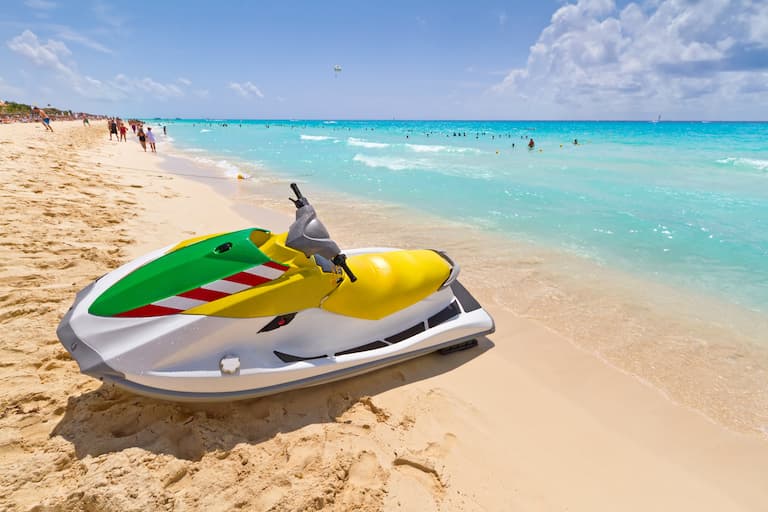
That said, here are seven fixes you can take once you’ve pinpointed the problem.
1. Examine Fuel Circulation Parts in Your Jet Ski
As I mentioned, a jet ski engine that’s flooded with fuel can be sluggish or appear to have stalled. If you think you may have flooded your jet ski’s motor, the first step is to try and get the air to fuel ratio back to normal again. If it’s safe to do so, turn off your jet ski’s engine and let it rest for around ten minutes to allow the excess fuel in the system to evaporate. Then, carefully turn the ignition on, taking care not to give it too much throttle.
Doing the above normally resolves a flooded jet ski motor. If it doesn’t, you’ll need to examine the motor parts involved with fuel circulation for damage or wear or tear, such as:
- Fuel line: The fuel line is a slender pipe connecting the carburetor and the gas tank.
- Carburetor: The carburetor is usually located underneath the fuel line. All you have to do is move the fuel line to one side, and you should see a metal-air pipe with a rectangular shape.
- Fuel valves: This regulates the fuel flow from the gas tank to the jet ski’s engine.
The parts should look clean and intact with no signs of damage or wear and tear. If you don’t know what to look for or don’t feel like tampering with your jet ski’s motor, I suggest that you contact a professional instead.
2. Remove Excess Debris or Clean Clogged Parts From The Jet Ski
If you believe your jet ski may have sucked in some lake vegetation or seaweed and your pump or impeller tube is clogged, turn the jet ski off and shake it back and forth a few times to try and dislodge the debris. Then, check the intake grate in front of the intake pump.
Remove any debris from the intake grate. If that doesn’t work, try gently clearing out the impeller tube or pump by hand. Avoid using sharp objects for this purpose, as they could dislodge it further and damage the part.
Instead, use an injector cleaner to clear out parts clogged with rust, dirt, or a mineral build-up. If rust is a problem, consider applying dielectric grease around the parts to repel water and prevent corrosion.
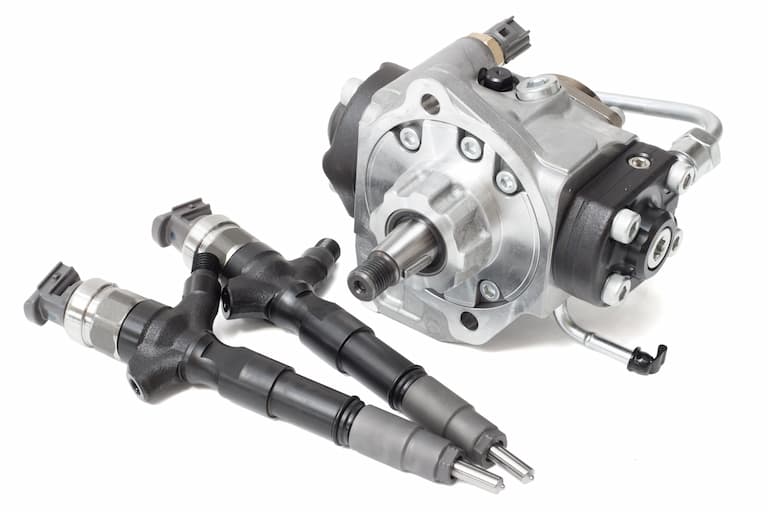
3. Repair or Replace Worn-Out or Faulty Parts On Your Jet Ski
Regular jet ski maintenance is essential if you want it to run optimally, and this involves replacing worn-out or faulty parts. Here’s how to repair or replace the most common jet ski parts that become damaged or worn out.
- Spark plugs: Spark plugs can get wet, so it’s important to allow them to dry out. If you need to replace them, doing so can be challenging due to the rust binding them to the engine head. Saturating them with penetrating oil and leaving it for a few hours or overnight normally loosens them.
- Jet pump: If your jet pump is damaged or worn out, it’s best to replace it. You can take your jet ski to a professional or replace the pump yourself if you know your way around the engine.
- Key switch: Repairing the key switch can be difficult, so replacing it is your best bet. You can buy a key switch from your jet ski manufacturer or have a professional do it for you.
- Ignition coil: The ignition coil is one of a jet ski’s most vital parts, so it’s a good idea to replace it if it’s damaged or worn out.
- Injectors: Jet ski injectors can often get clogged. Luckily, you can use an injector cleaner to remove debris or build-up within that component.
4. Use Water-Removing Additive in Your Jet Skis Fuel Tank
If you believe your jet ski is turning off because there’s water in the fuel, consider using a water-removing additive. Note, however, that water-removing additives are only effective if there’s more fuel than water in the tank. Alternatively, you can siphon out the problematic fuel and replace it with better quality fuel that doesn’t have a high ethanol content.
After refilling your jet ski’s gas tank, use a fuel stabilizer to keep it fresh, prevent water build-up, and clean the motor’s carburetor and fuel injectors.
5. Replace the Jet Skis Dess Switch To Keep it Running
The first step to solving a dess switch problem is to ensure that the dess key and key post are dry. If not, dry them thoroughly, and try again. Note that the dess switch can be vulnerable to seawater corrosion, which can damage the wiring and cause the dess system to misfire. In these cases, you’d need to replace the dess switch.
6. Repair Any Loose Connections On Your Jet Ski
You can fix a loose connection in the start/stop switch by checking the connectors near the ignition box. If you notice moisture around the connections, remove it and place some dielectric compound around them. Dielectric compound (Amazon) is waterproof and helps protect electrical connections from dirt and moisture damage.
If the problem is not due to excess moisture around the connections, use a multimeter to conduct a continuity test and check whether the switch is faulty. If it is, take out the switch, clean it and apply some dielectric grease around it.
If that doesn’t solve the problem, there’s likely a bad wire you’ll need to replace.
If the issue is due to a problematic battery connection, tighten up the connections, and check if there are any bare spots on the wire leads indicating that the insulation has corroded. If you see these bare spots, replace the wires or reinsulate them.
7. Select the Correct Mode To Keep Your Jet Ski From Turning Off
Your jet ski might have stalled because you selected the wrong mode. In this case, all you have to do is choose the correct one by pressing the “mode” button. You can usually find the “mode” button on the jet ski’s left handlebar. The jet ski will likely work as it normally does after you select the most suitable mode.
Final Thoughts
Your jet ski may keep turning off for various reasons. It can be due to a faulty or clogged part, loose connection, water-contaminated fuel, mode problem, or a dess switch signal problem.
You can fix these problems by identifying loose connections or dirty or worn-out parts, and then cleaning, repairing, or replacing them.
If your jet ski has flooded, you can turn it off and wait a while before starting again.
A water-removing additive removes excess moisture in fuel, and adding a fuel stabilizer helps repel water, keep the fuel fresh, and keep the carburetor and fuel injectors clean.


